This Hakka Noodles taste delicious and will have you craving for more. I am sharing a vegan version loaded with veggies and button mushrooms. Fairly easy to make hakka noodles is a popular Indo-Chinese dish of stir fried noodles. You will find it being made and served in many restaurants and street-side Chinese food joints in India. Hakka noodles is not only popular with kids, but also with grownups.
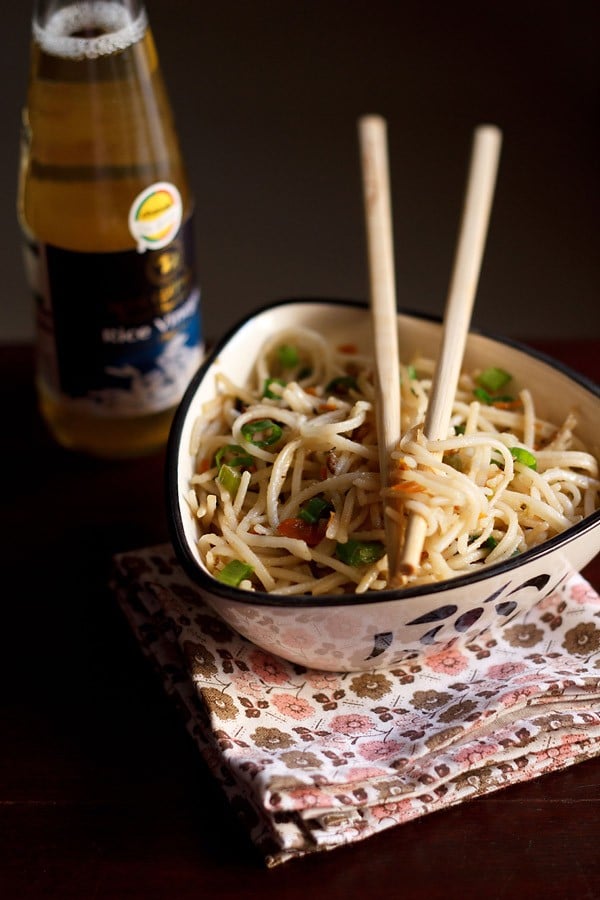
Ingredients You Need
- Hakka Noodles – Use any Indian brand of Hakka Noodles. I have used Ching’s Hakka Noodles. Note that these noodles is made with all-purpose flour so if you prefer a healthier version, then use whole wheat noodles or soba noodles (buckwheat noodles)
- Veggies: You can add veggies of your choice. Mushrooms give a meaty texture and umami flavor. If you do not like mushrooms you can skip them. You can choose from the following list of veggies:
- cabbage (green or red)
- carrots
- french beans (green beans)
- zucchini
- broccoli
- button mushrooms or cremini mushrooms
- capsicum (bell pepper)
- spring onions (scallions) or regular onions
- Soy sauce: Try to use naturally fermented soy sauce as it gives a lovely fermented taste and flavor to the noodles. You can even use bragg liquid aminos or tamari instead.
- Toasted sesame oil – The noodles get a lovely hint of smokiness from toasted sesame oil. But do not worry if you do not have toasted sesame oil. Just use any other neutral tasting oil like sunflower oil or safflower oil.
- Herbs and spices: Garlic, dry red chillies, celery or coriander leaves (cilantro) are the herbs and spices added. Celery is not available everywhere in India. So if you do not have celery, then just skip it. Use green chillies instead of dry red chillies.
- Rice vinegar: Instead of rice vinegar you can add white vinegar or apple cider vinegar. You can even use rice wine or mirin. Both rice vinegar and rice wine give a distinct flavor and aroma to the dish.
Note on Celery
Many Indian readers ask me what is celery and where to get it. Celery is a herb that is easily available in most superstores and supermarkets in Indian metros.
You can also grow celery in a pot. Either buy the plant from a nursery or plant the seeds. The best way is to chop the celery from its base and plant the base in the soil. Here is a shrub of celery from my balcony herb garden.
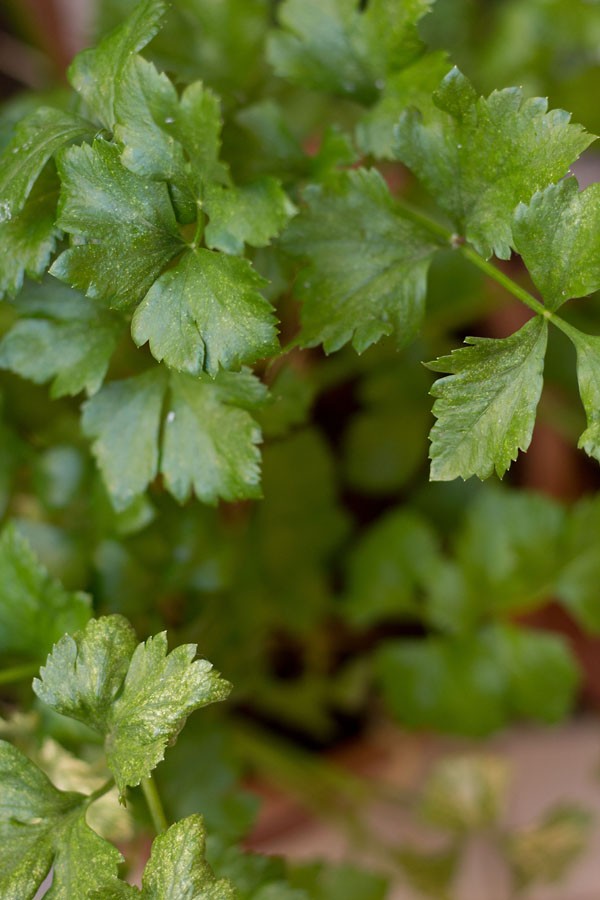
How to make Hakka Noodles
Prepare Veggies and Cook Noodles
1. First finely chop all the veggies and keep aside. You can even shred or grate the veggies using a food processor. I have used carrots, french beans, spring onions, button mushrooms, capsicum and cabbage (in the video).

2. Boil 4.5 cups water in a pot or pan with ½ teaspoon salt and a few drops of oil.
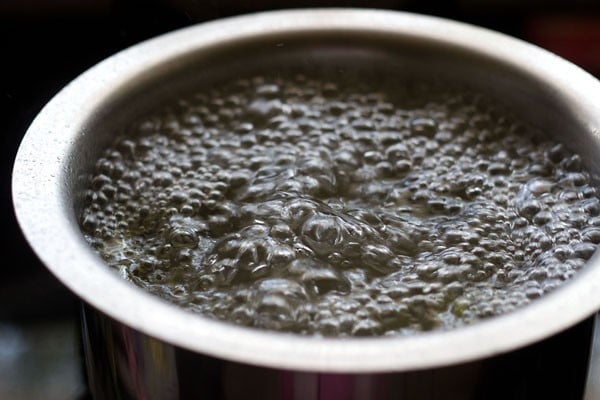
3. Add the hakka noodles (200 grams).
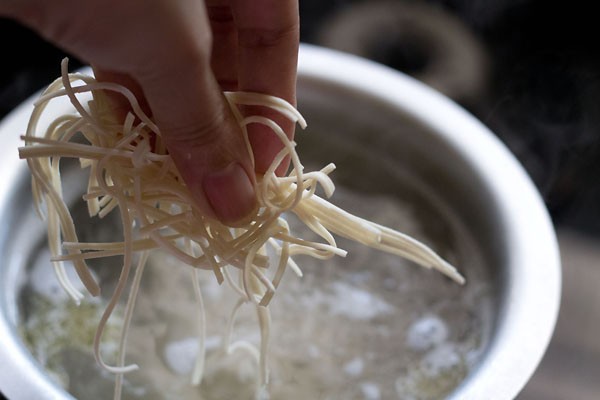
4. Cook the hakka noodles according to the package instructions. The noodles have to be cooked till al dente or just about cooked.
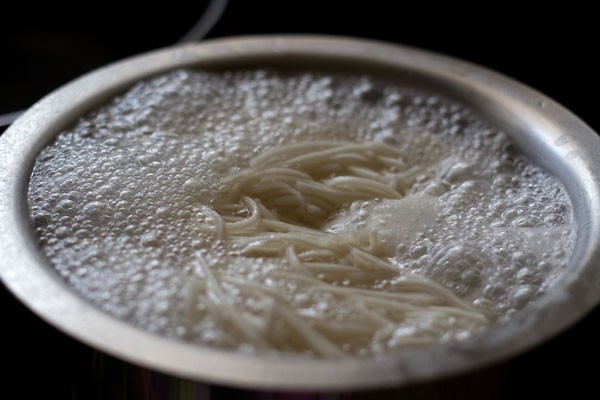
5. Drain cooked noodles in a colander. Then rinse noodles with fresh water very well. This stops the cooking process and removes the starch.
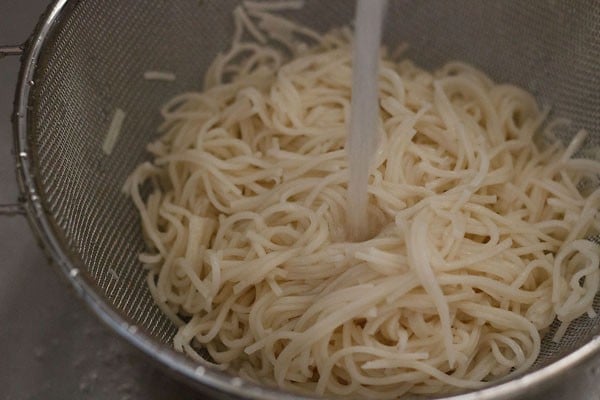
6. Add 1.5 teaspoons of toasted sesame oil.

7. Toss noodles well, so that the oil gets coated evenly on them. This gets rid of stickiness from them.
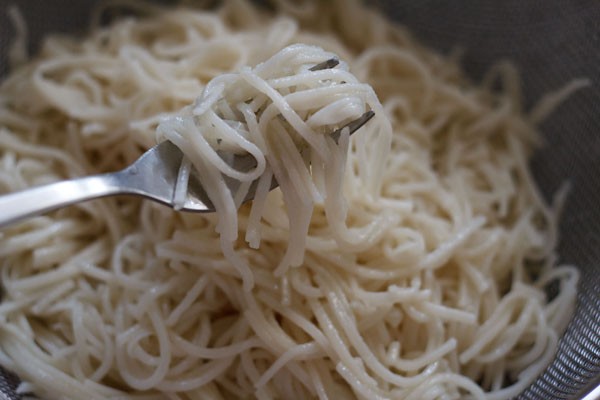
Stir Fry Spices, Vegetables
8. Heat 2 tablespoons sunflower oil (or any neutral tasting oil) in a frying pan or wok. On a medium-low to medium heat, first sauté 2 to 3 dry red chilies (broken and seeds removed) and 1.5 teaspoon finely chopped garlic for about a minute.

9. Increase the heat a bit and then add the 3 to 4 small spring onions (finely chopped), 8 to 10 french beans (finely chopped). Stir fry for about 3 minutes.
Pro Tip: For non-stick frying pans, keep the heat to medium and for cast iron or carbon steel pans or wok, use medium-high to high heat.
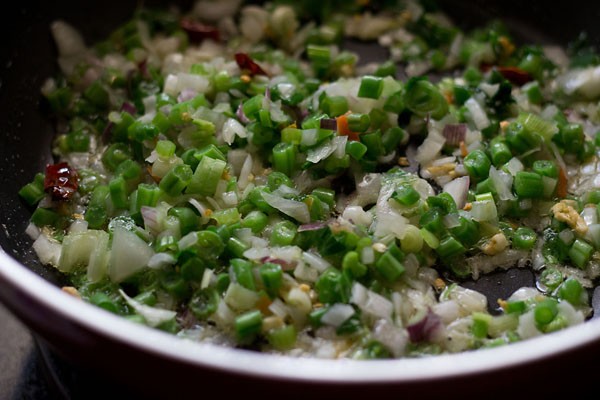
10. Add the 4 to 5 button mushrooms (finely chopped), 1 small to medium carrot (finely chopped) and 1 teaspoon finely chopped celery and continue stir-frying.
You can also add ½ cup finely chopped cabbage and 1 small to medium capsicum at this step. For the hakka noodles video in the post, cabbage is added.
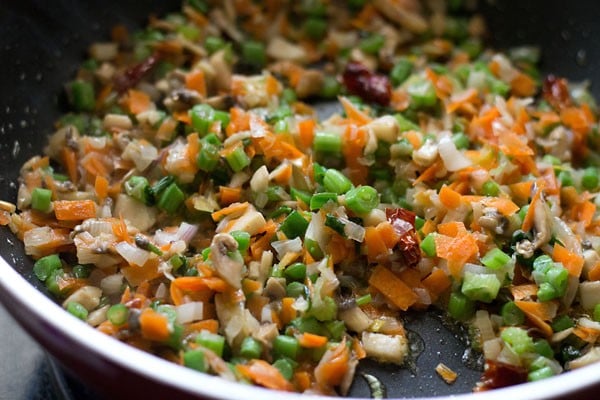
11. Stir fry for about 5 to 6 minutes till the edges of the veggies start to slightly brown. I like the veggies to be cooked more, than what is the norm usually for this recipe. You can cut down on the stir frying time, if you prefer half cooked or more crunchy veggies.
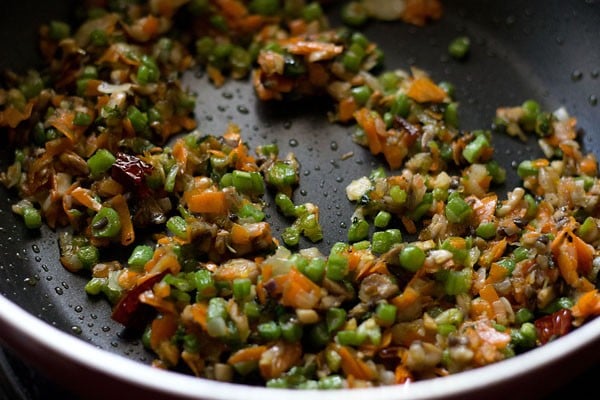
12. Add 1.5 teaspoon soy sauce and mix well.
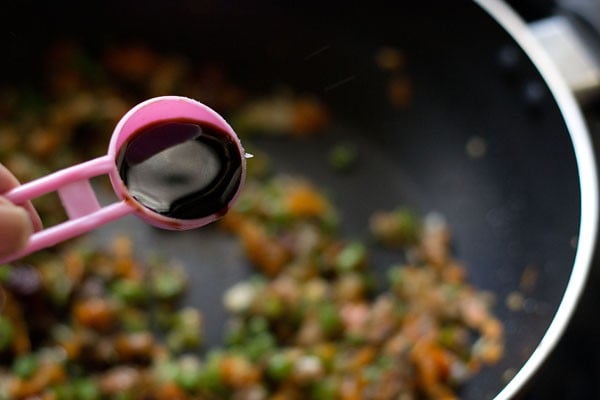
Make Hakka Noodles
13. Add the cooked noodles. Mix, keep on tossing and stir-fry noodles for 1 to 2 minutes.
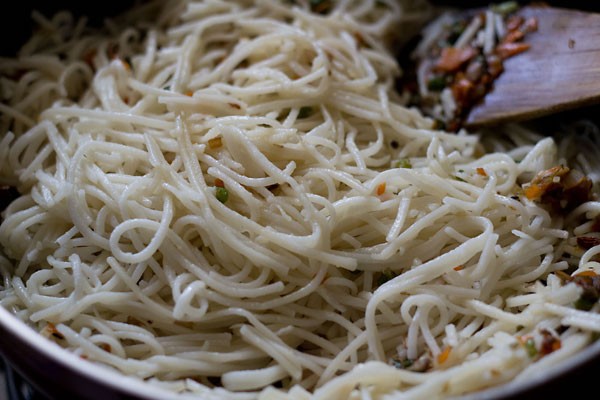
14. Season with salt and crushed black pepper as per taste. Add ¼ teaspoon rice vinegar or white vinegar or rice wine.

15. Toss well again and stir fry for a minute. Switch off the flame and add 1 to 2 tablespoons spring onion greens and mix well. Or you can garnish with spring onions while serving.

16. Serve Hakka Noodles hot as it is or accompanied with an Indo Chinese dish like Gobi Manchurian or Paneer Manchurian or chilly mushroom or mushroom manchurian.

Expert Tips
- Chopping veggies: The veggies added to noodles have to really chopped fine or cut into julienne or shredded as all the stir frying is done at a medium to high heat and in less time.
- Cooking noodles: Boil noodles till they are al dente – meaning having a slight bite to them. The noodles are again stir-fried on a high heat which makes them cook again. You don’t want to have overcooked or pasty noodles.
- For non-sticky noodles: Rinse the cooked noodles in fresh water very well. This method stops the cooking process and removes the starch. Toss and mix then cooked noodles with some oil. This gets rid of the stickiness from them and they do not become lumpy.
- Frying pan or Wok: Make sure to use a wok or kadai or a frying pan with handles, so that you keep on moving the pan when tossing and stir-frying them. Cast iron or carbon steel pans work great for stir frying on high heat but you can easily make these noodles in a regular Indian kadai or even a frying pan.
- Authentic Chinese flavors: Though they can be skipped, but to get an authentic Chinese style taste and flavor, I recommend adding these three ingredients which make a lot of difference to the final dish. You can add all or either one of them.
- Toasted sesame oil
- Celery
- Rice vinegar or rice wine.
- Stir-frying: Usually in restaurants and street stalls, the ingredients are stir fried at a very high heat which gives that smoky flavor to the dish. In a regular home kitchen it is difficult to replicate such a high heat. So you can use a medium to medium-high or high heat of your burner stove and make this dish. For non-stick pans, stir fry on medium heat.
- Gluten-free options: To make gluten-free version use gluten-free noodles and tamari or bragg liquid aminos.
More Popular Noodles To Try!
Indo Chinese Recipes
Indo Chinese Recipes
Indo Chinese Recipes
Indo Chinese Recipes
Please be sure to rate the recipe in the recipe card or leave a comment below if you have made it. For more vegetarian inspirations, Sign Up for my emails or follow me on Instagram, Youtube, Facebook, Pinterest or Twitter.
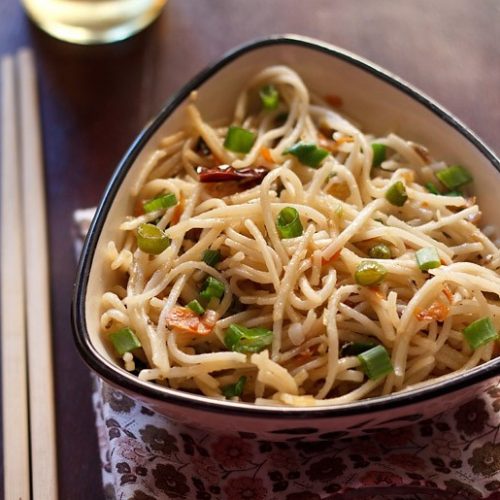
Hakka Noodles (Indo Chinese Style)
Ingredients
For cooking hakka noodles
- 200 grams hakka noodles or 1 pack of Ching's hakka noodles
- 4.5 to 5 cups water
- 1.5 teaspoons toasted sesame oil – for coating the noodles
Other ingredients
- 2 tablespoons sunflower oil or any neutral tasting oil – for stir frying
- 2 to 3 dry red chilies – broken and deseeded or fresh green chilies, chopped
- 1.5 teaspoons finely chopped garlic
- 3 to 4 spring onions (scallions) small-sized – finely chopped, reserve a few greens for garnish
- 8 to 10 french beans – finely chopped
- 4 to 5 button mushrooms – finely chopped * check notes
- 1 carrot – small to medium, finely chopped or shredded
- 1 bell pepper (capsicum) – red, green or yellow, small to medium, finely chopped or thinly sliced
- ½ cup finely chopped cabbage – optional
- 1 teaspoon finely chopped celery – optional
- ¼ teaspoon rice vinegar or white vinegar or rice wine or mirin
- 1.5 teaspoons soy sauce (naturally brewed) or tamari – add as needed
- salt as required
- crushed black pepper as required
- 1 to 2 tablespoons chopped spring onions greens or coriander leaves – for garnish
Instructions
Cooking noodles
- Heat enough water in a pan with salt and a few drops of oil, till it comes to a boil.
- Add the hakka noodles and cook according to the package instructions.
- When noodles are cooking, rinse and chop all the veggies or you can chop them before you start cooking noodles.
- Drain and rinse noodles in running water, so that the noodles stop cooking.
- Then add toasted sesame oil and gently mix, so that the oil gets evenly coated on them.
- Set the cooked noodles aside.
Stir-frying
- Heat oil in a wok or kadai or a frying pan.
- On medium-low to medium heat, first add the dry red chilies and garlic.
- Saute for a minute, then add the finely chopped spring onions and french beans
- Increase the flame a bit and stir fry for 3 minutes. For non-stick frying pans, keep the heat to medium and for cast iron or carbon steel pans or wok, use medium-high to high heat.
- Add the mushrooms, carrots, bell pepper (capsicum) and celery.
- Stir fry all the veggies on a high flame till they start getting slightly browned from the edges. This will take about 5 to 6 mins after adding the carrots.
- Add soy sauce and mix well.
Making hakka noodles
- Add noodles and toss it well and stir fry for a minute or two on high heat.
- Season with salt and pepper. Also, add rice vinegar or white vinegar. Continue to toss and cook on a high flame for a minute.
- Toss the whole mixture well and add the chopped spring onion greens or garnish with spring onions while serving.
- Serve hakka noodles plain or accompanied with manchurian curry or gobi manchurian or chilli mushroom.
Video
Nutrition Info (Approximate Values)
This hakka noodles post is from the archives was first published on Feb 2014). It has been updated on November 2024.
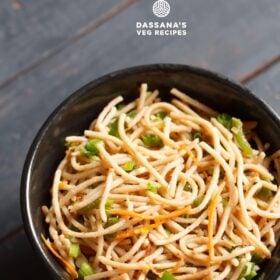



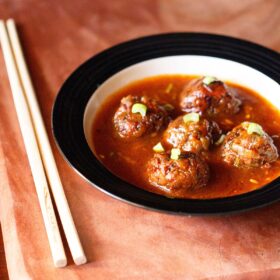

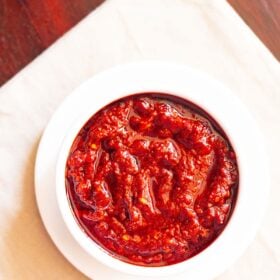
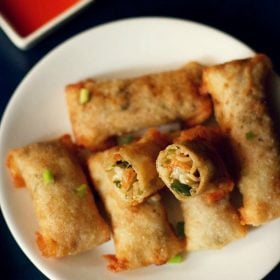








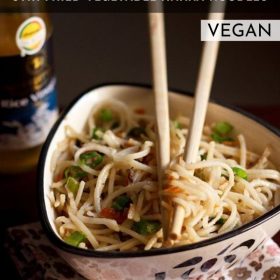
Good taste.
Absolutely amazing taste.
Thank you.
All the receipe i have tried are super duper awesome. I have learnt cooking from.your receipe… Love you. I want receipe for dryfruits immunity laddu…plz help
Thanks a lot. I have shared dry fruits laddu recipe. You use the search icon/button for the recipe and will get it.
It is very helpful .
I really like this.
Thank you .
welcome and thanks.
Good. Amazing. Loved it!
The best hakka noodles recipe ever. Have made it so many times and have received plentiful praises for the noodles.
thanks for the feedback and rating lopamudra. glad you have liked the hakka noodles recipe.
THank you for this recipe. It was easy, healthy, and delicious!
welcome and thanks rekha.
Dassana,
You inspire me to cook ! I would say you are my cooking mentor. I refer to your recipes most of the times. Thanks so much for putting up this great work…
thank a lot vasu ???? glad to know that the recipes are helping you. happy cooking ????
Hello Mam, i want to know the difference in taste among soya, light soya and dark soya sauce? How these 3 different varities make a difference in dish?
meenakshi, the taste is different. light soya sauce is a lighter and milder version of soy sauce. whereas dark soy sauce has obviously more stronger flavor and color. regular soy sauce compared between the two. dark soy sauce is good for marinating. whereas for stir fries, light soy sauce or regular soy sauce works well. taste is different of all three.
Hi….your all recipes works fantastic all time…thanks a ton????????????
Welcome Amruta
wow I tried the Hakka noodles. those were so yummy
Thanks Capt.Nikhil
Your site is like my recipe book… any item i want to try… i just check ur space and i have it… each one comes out delicious and fantastic… thanks to ur detailed steps.
Welcome Carol. Thanks for sharing your positive feedback.
Made hakka noodles for the first time using this recipe and they came out fantastic! Thanks a ton! 🙂
Welcome Kiran. Glad to know that you liked the noodles recipe.
hi dassana..made hakka noodles but they came out to be sticky…otherwise was superb..thanks a lot… thumbs up ?
welcome farah. if you put a few drops of oil to the noodles after they have cooked then they won’t be sticky.
thanks for the receipe.
i wanted to make noodle for my Daughter B Day party.
so i wanted to know hwithout getting dry or sticky, how i keep boiled noodle fresh for long time.
welcome chitra. adding a few drops of oil while the noodles are cooking, helps in making then non sticky. even adding oil after the noodles are strained, keeps them non sticky and dry. also cover the cooked noodles with a lid.
hi dasana,
I have tired a few receipes of yours and today i am going to try hakka noodles tomorrow.
I wanted to tell u that many times I do no get the leave response section.
thanks trupti. the response section was closed for some days as we were migrating the website to a new server.
Your Hakka noodles recipe are s ooooooo good.
thanks irene
Awesum n sooooooooo guddd
thanks shweta for sharing positive feedback.
Superb and easy made
Sooooooooooooooooo goooooood”……..
thanks deekshita
I am really curious. I did use this recipe. it turned out good.
BUT, what i really want to know is why doesnt it taste similar to how it is when we eat outside? I just feel like it doenst taste the same. I know its unique in every restaurant, but there is some form of similarity which i dont find it when cooking home.
Is there a reason? :/ i really need to know. been searching for recipe for restaurant style for ages.
thanks fahim for the feedback. in restaurants msg is added. hence the taste is not same. home cooked chinese without msg will not taste like restaurant ones. another factor is they heat the pans/woks etc on a very very high flame which gives a smoky aroma & flavor to the stir fried food. this cannot be achieved while making at home.
thats Interesting. How much MSG would you suggest adding?
But thank you for the reply :). appreciate it
Also, why do you not use it? 🙂
welcome fahim. msg has some side effects on the body and thats why i don’t add it. if you do a google search, you will find the side effects.
hi ur recipes r really good specially this one 🙂
thanks radhika
Hi, thanks for all the amazing recipes on your site! Quick question…can I make all your Chinese noodle recipes with spaghetti instead? I find that the packaged Hakka noodles and instant noodles in the market have a lot of msg and oil. So wondering if I can use spaghetti and expect the taste to be reasonably ok?
Separately, for the manchurian balls recipe, I’d like to bake instead of frying the balls. Any thoughts on how high to pre heat the oven and how long to bake? I’ll follow the rest of the recipe exactly 🙂
Thanks so much!
Welcome PC. yes you can make chinese noodles with spaghetti. the taste will be fine as it depends upon the sauces and spices you add. i have never tried baking the manchurian balls. you will have to give a try. just lightly brush them with oil and bake them at 180 degree celsius.
I tried hakka noodles &it came out well. Thanks.
welcome renu. thanks for the feedback.
Can i use egg noodles instead of hakka? I am planning togive a try tom.
yes you can add egg noodles.
Always refer ur recipes.
Very helpful
kanishka, glad to know this. keep visiting the blog.
Very yummy
thanks kavita
Will try your recipe
I tried the recipe yesterday.. and as usual it turned out fantastic.. My husband and I loved it.. Will try it more often now when my in-laws and parents visit.. I was feeling proud of myself coz I neva thought that I could cook Chinese without anything going wrong.. We clicked a few pictures and sent it to my Mum and she surely was impressed.. 🙂 I am glad you posted this recipe. Thanks a tonn..
thats great to know pooja. cooking chinese is pretty easy. also one can adjust the seasoning as per one’s taste. in noodles, one can do a lot of varitions, by adding different flavored sauces and veggies.
Hi,
Tried out this with paneer manchurian, came out well.ur right adding celery makes a lot of difference in taste.tried manchurian earlier also but without celery,this time taste is no doubt far better.
one doubt ,i used fresh celery.which is better for Chinese dishes dry or fresh celery.
Thnx
fresh celery is better. its gives a nice fresh aroma of the celery in the dish. in fact in our home science classes, we were told to include celery in the chinese cooking. that time wher i lived, we did not get fresh celery. so even with the same recipes, the taste and flavor was different.
Hi dassana
Your recipes are fantastic
I am nt so pro in cooking ..so hav to keep referring to net for gd recipes of even the simplest stuff.. Earlier I visited tarla dalal etc sites bt once I happened to see ur blog n tried the recipe. Since then I hav been a Bigg fan.. the step by step instructions with photos n then consolidated recipe are a boon to pple like us. U also give valuable suggestions for trying variations. So a big big thank you… keep blogging.. al the best
Best wishes
Manali
hi manali, thanks a lot. i am glad that the step by step instructions are helpful and the recipes come out good.
Tried it came out nice……by the way
.do u use any manure for ur home kitchen plants….if yes can u share…coz ur celery looks great
i use natural manure (made from natural materials for composting) and vermiculture compost which i buy from outside. i don’t know which brand they are. we have an annual plant and flower exhibition here and i buy in bulk from this exhibition.
hi dassana ,
I tried this recipe.it came well and taste also good. all your posts are good
and easy to follow. I like the way of your presentation on the menus.It shows
your love on cooking.keep going.we support u.
regards,
priya.
thanks priya for this sweet feedback. reading such positive feedback, i feel more motivated and inspired to blog.
Hi Dassana,
I hv been following your recipes since almost an year now…n I really like dis stepwise illustration.thanks alot for d wonderful recipes.i love cooking and yr blog hs made me a get fan of yours.
welcome neha and big thanks for this motivating feedback.
The recipe, the step by step pictorials and the end result – All outstanding! We prepared it and the vessel in which it was made has never been cleaner, after my son and husband were done eating. Loved it! Thanks for sharing.
welcome sonika. your comment made by smile.
I liked the idea of red chillies and garlic saute in the beginning. I did that and didnt need any hot spices after. It was a good kick!
thanks for sharing your variation.
Hi,
For the celery, do you use the stalks or the leaves?
i use the stalks. but sometimes i add the leaves too. but less of leaves and more of stalks.
Tried it. Very simple to follow and came out very well like your other recipes. I am a fan!
thanks anu.
nice
Thank you very much for such wonderful recipes .
welcome pushpa
I am a big fan of your recipes. I try them all the time. I used to like Chinese noodle but my Ayurvedic doctor forbade me to have them as it upsets my stomach .
Can noodles be cooked with Indian spices ?
Bye
Suman
thanks suman. yes noodles can be cooked with indian spices.
Thanks for all the awesome recipe..you make cooking easy n fun.. I would rate all ur recipes 10/10
Thanks for sharing it with us:)
welcome rose and thanks for the 10 out of 10 rating 🙂
Hello
Wow what a recipe. Yum Yum Yummy…Definitely going to try this at my own.
Thanks for sharing this such an awesome recipe.
Cheers
Sakshi
welcome sakshi
Hi Dassana,
Nice post. And I have one silly doubt. What is the difference between Hakka noodles and plain instant noodles?
hi akriti. actually there are many many variations of making noodles and hakka noodles happens to be one of them. these noodles come from the hakka province in china. they were brought to india, by the chinese migrants from the hakka province. its they who have made hakka noodles popular in india. also the kind of noodles that is used for hakka noodles is different from the instant noodles.
I like this tasty Indo-Chinese recipe!
Hi Dassana, Another fabulous recipe. Will try it out for sure ! 🙂 One question…which oil do you use/recommend for stir frying chinese recipes??
hi radhika, you can use any light non flavored oil. here i had used rice bran oil. but sometimes i use sesame oil too. you can use the regular sesame oil or the asian one. both work well in indo chinese recipes.